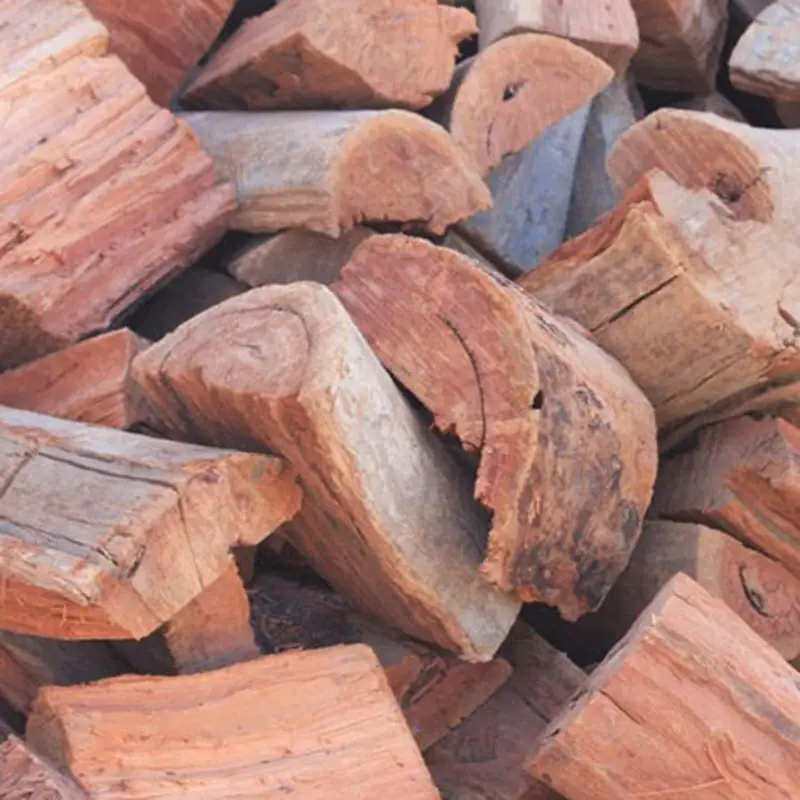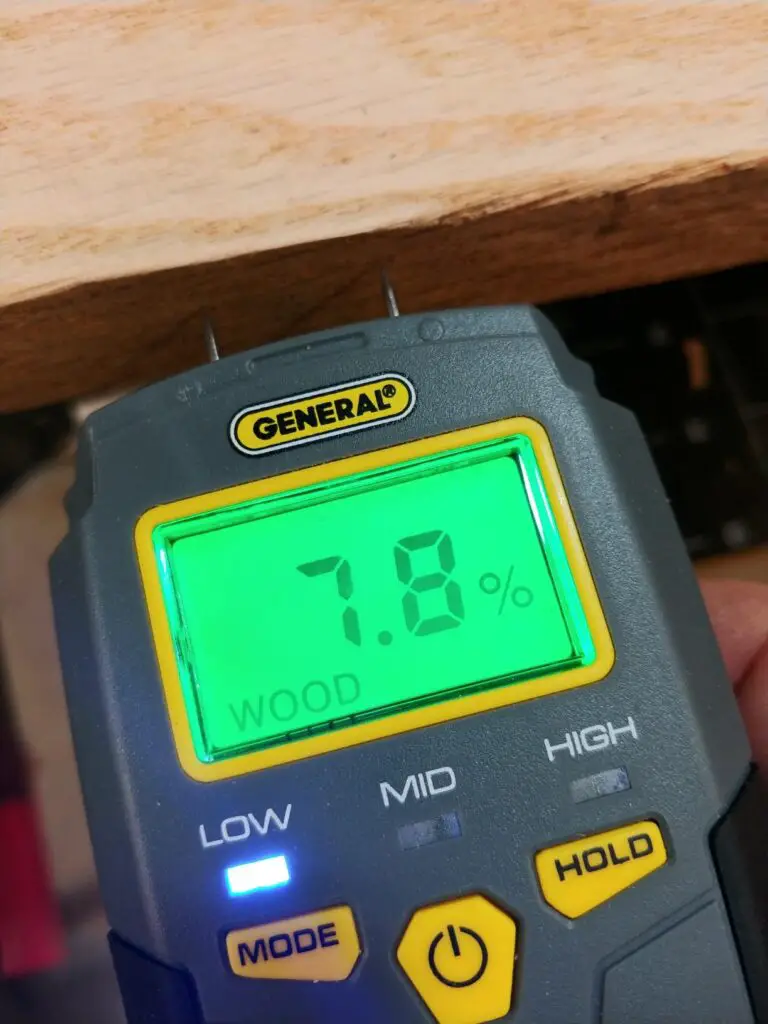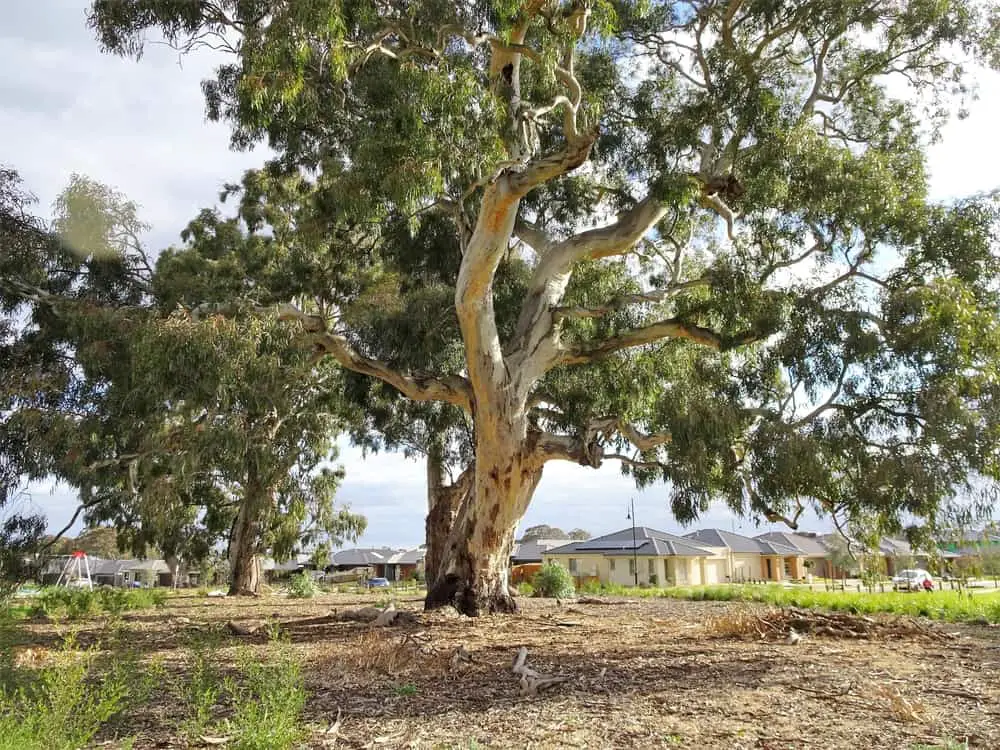Redgum is good firewood with high heat production and low smoke generation, but it is very difficult to split and can take up to 2 years to season.
Redgum is a type of Eucalyptus tree that is endemic to Australia but now grows throughout southern California. It was brought to the United States as seeds in the 1800s, which meant that it didn’t bring along any pests that would limit its growth. The redgum is a fast-growing tree and quickly spread throughout California and the southern US states.
It spread quickly as investors looked to grow large hardwood forestries. The reason that redgum is so beloved as firewood is the same reason that it is so hated as a tree – it burns hot!
In this article, I will aim to look past its controversial history as a tree and focus on its properties as firewood.
Table of Contents
Summary
- BTU: 34.5 million BTUs per cord
- Weight: 7320 Ibs. Green
- Seasoning Time: 18-24 months
- Splitting Difficulty: Difficult
- Sap Content: Low
- Smoke: Low
- Smell: Sweet and medicinal
Overall, redgum firewood is very popular because of its high heat production, low smoke generation, and sweet smell.
However, there are some real disadvantages with this wood. The first is its difficulty in splitting. This hardwood can be very stringy – these fibers hold the wood together and seem almost impossible to split after seasoning. The eucalyptus oil is also present in the wood, which is why it takes so long to season. If you burn unseasoned wood, you will notice a popping sound as pockets of oil ignite.

Heat Production
The heat production for redgum is exceptionally high, with a rating of 34.5 million BTU per cord. This is one of the hottest burning woods in the US. This high heat production is because of the high oil content, which is why redgum has become so popular as firewood.
It also produces high-quality coals that are ideal for cooking or overnight heating. There won’t be much ash left after the fire has gone out.
Smoke Production
The amount of smoke produced by redgum is low as long as the wood is seasoned correctly.
If you have not seasoned the wood properly, you will notice popping and sparking from oil pockets inside the wood. This will increase the smoke production. If you are burning unseasoned wood indoors, you will need a screen or glass door to prevent smoke from spreading throughout the house. I always recommend not burning unseasoned wood indoors, especially for redgum.
You should also be aware that redgum leaves, like all eucalyptus, can be dangerous when ingested or burnt and the smoke inhaled. I always ensure that all leaves are removed when burning redgum, especially camping.
Seasoning Time
Redgum has a low sap content compared to other woods, but it contains more oil, increasing the moisture content. To season firewood properly, you will want to reduce the moisture content to below 20%. Redgum does take a significant amount of time to reach this goal because of the oil.
Seasoning redgum will take 18-24 months. This depends on the storage design and the environment – hotter and windier locations will dry faster.
If you burn unseasoned redgum you will notice a lot of crackling and popping as small pockets of oil ignite. I don’t recommend burning redgum inside until it is thoroughly seasoned to reduce the likelihood of oil popping.
I personally recommend this General Tools Moisture Meter. It allows you to accurately gauge how wet your firewood is and whether it is sufficiently seasoned. Over time you can also see how quickly the moisture is dropping and how much longer you need to keep your firewood dropping until it is seasoned and ready to burn.
Press the sharp pins into the wood and you will quickly see the readout show the moisture ranging from 5% to 50%. It also has a Low/Mid/High indication depending on whether the wood is dry enough, so you don’t need to remember the actual values.

Burning Smell
Redgum and other Eucalyptus species have a delightful smell that will remind you of Vicks VapoRub, which smells sweet and slightly medicinal to most. The scent will not be overwhelming, and most enjoy the fragrance of the wood.
Creosote Buildup
Creosote is a dark brown tar deposited from wood smoke that can build up on the insides of your chimney walls. It contains tiny unburned particles of wood and sap found in smoke. Creosote can be extremely dangerous because of how flammable creosote is and will quickly start a chimney fire. Firewood with higher levels of sap will create more creosote.
Burning redgum firewood is clean and easy if you season it for long enough. If you do not season your redgum firewood long enough, the risk of creosote buildup increases significantly because of the extra oils in the wood.
Splitting
One of the main disadvantages of redgum is how difficult it is to split, mainly after it has seasoned.
This is because the wood fibers are very stringy and twists together as the wood drys out. In my experience, the best chance to split the wood is around 5-7 days after the tree was felled. This allows some time for the moisture and oil to leave the wood before any fibers twist.
I recommend using a log splitter for hardwoods, especially if you have a lot of wood to split and stockpile. This is not the kind of wood that you want to spend a few days splitting by hand.
Different Types/Species
The redgum is a species of Eucalyptus tree. There are over 700 different eucalyptus species, but I have listed the most common varieties found in the United States:
- Southern Blue Gum
- Cider Gum
- Snow Gum
- Silver Dollar Gum
- White Peppermint
- Spider Gum
- Blue-Leaved Mallee
- Mountain Gum
- Rainbow Gum
- Omeo Gum
- Candlebark
- Willow-Leafed Peppermint
The Eucalyptus species is a hardwood variety that is fast growing and suited for fire-prone areas, such as California, Texas, and Flordia, due to its ability to sprout back after being burned.

Comparison to Other Woods
Here, I’ve taken some of the most popular firewoods to burn indoors and compared them to redgum firewood.
| Firewood | BTUs | Ease of Splitting | Coals | Overall Quality |
| Green Ash | 20.0 | Easy | Good | Excellent |
| Maple | 25.5 | Easy | Excellent | Excellent |
| Bur Oak | 26.2 | Easy | Good | Excellent |
| Redgum | 34.5 | Difficult | Excellent | Good |
Redgum has a mixed reputation because it is difficult to find in many areas, is hard to split, and has a very long seasoning time. It has as many negatives to its positives as having very high heat output and great burning qualities.
FAQs
How do you identify redgum trees?
Redgum trees have bark that peels off all year round. They have a blue-green leathery leaf that is filled with oil. They also have cup-like flowers that look like nuts.
Can you burn redgum in a wood stove?
Yes, but use a fire screen or glass doors when burning inside to avoid house fires from popping wood. Ensure your redgum wood is completely seasoned before burning inside.
It is a common misconception that burning eucalyptus firewood is dangerous or poisonous. The poisonous part of the eucalyptus tree is if you ingest a large number of its leaves. If you were to do this, you would experience stomach pain, dizziness, and nausea. As long as you don’t burn the leaves, you don’t need to worry about any dangers.
How much does redgum firewood cost to buy?
It will cost you around $160 for a cord of redgum, depending on availability and time of year.
Final Thoughts
There are certainly some negatives to burning redgum firewood, but it burns hot for a long time and leaves excellent coals. It also has a pleasant smell that many people enjoy. It is a tough wood to split, so make sure you use a log splitter if you have a lot of wood to process.
Redgum firewood is one of the best firewood to burn because of its smell and high BTU heat production.
